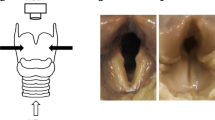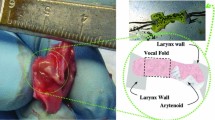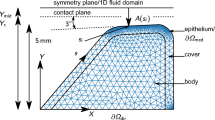Abstract
It is common practice in laryngeal research laboratories to store excised larynges and vocal fold tissue specimens frozen, presumably to preserve viability and structural integrity of the specimens for physiologic and biomechanical experiments. However, little is known about the biomechanical effects of postmortem changes and frozen storage in vocal fold tissues. This study attempted to quantify the effects of postmortem changes and freezing on the viscoelastic shear properties of the canine vocal fold mucosa. Sixteen larynges were excised from adult dogs immediately postmortem in a viable state. Using a torsional rheometer, the complex shear modulus (G*) of the mucosal tissue from one vocal fold of each larynx was measured as a function of frequency (0.01–15 Hz) by linear small-amplitude oscillation experiments. Measurement was repeated for ten mucosal specimens after 24 h of postmortem storage in saline solution at room temperature. Eleven of the 16 larynges were frozen and stored at −20°C, six of them at a slow rate of cooling (storage in a regular freezer) and five others by quick freezing (chilling by liquid nitrogen prior to frozen storage). The larynges were thawed slowly overnight after one month and the viscoelastic shear properties of the contralateral vocal fold mucosa were measured. Results showed that the elastic shear modulus (G′) and dynamic viscosity (η ′) of the vocal fold mucosa did not seem to change significantly after 24 h of storage in saline at room temperature, nor after one month of frozen storage following quick freezing, whereas both G′ and η′ decreased significantly for tissues that were slowly frozen. These findings supported the feasibility of using quick freezing to preserve laryngeal tissues for in vitro biomechanical testing, for excised larynx experiments, and for tissue engineering applications. © 2003 Biomedical Engineering Society.
PAC2003: 8719Rr, 8719Pp, 8780–y
Similar content being viewed by others
REFERENCES
Alipour, F., D. A. Berry, and I. R. Titze. A finite-element model of vocal fold vibration. J. Acoust. Soc. Am.108:3003–3012, 2000.
Alipour, F., and I. R. Titze. Elastic models of vocal fold tissues. J. Acoust. Soc. Am.90:1326–1331, 1991.
Alipour, F., and I. Titze. Active and passive characteristics of the canine cricothyroid muscles. J. Voice13:1–10, 1999.
Allenspach, A. L., and T. G. Kraemer. Ice crystal patterns in artificial gels of extracellular matrix macromolecules after quick-freezing and freeze substitution. Cryobiology26:170–179, 1989.
Bendall, J. R. Postmortem changes in muscle. In: The Structure and Function of Muscle, edited by G. H. Bourne. New York: Academic, 1973, Vol. 2.
Benninger, M. S., D. Alessi, S. Archer, R. Bastian, C. Ford, J. Koufman, R. T. Sataloff, and J. R. Spiegel. Vocal fold scarring: Current concepts and management. Otolaryngol.-Head Neck Surg.115:474–482, 1996.
Berry, D. A.Mechanisms of modal and nonmodal phonation. J. Phonetics29:431–450, 2001.
Bozzola, J. J., and L. D. Russell. Electron Microscopy: Principles and Techniques for Biologists. Boston: Jones and Bartlett, 1992.
Chan, R. W., and N. Tayama. Biomechanical effects of hydration in vocal fold tissues. Otolaryngol.-Head Neck Surg.126:528–537, 2002.
Chan, R. W., and I. R. Titze. Viscosities of implantable biomaterials in vocal fold augmentation surgery. Laryngoscope108:725–731, 1998.
Chan, R. W., and I. R. Titze. Viscoelastic shear properties of human vocal fold mucosa: Measurement methodology and empirical results. J. Acoust. Soc. Am.106:2008–2021, 1999.
Chan, R. W., and I. R. Titze. Hyaluronic acid (with fibronectin) as a bioimplant for the vocal fold mucosa. Laryngoscope109:1142–1149, 1999.
Chan, R. W., and I. R. Titze. Viscoelastic shear properties of human vocal fold mucosa: Theoretical characterization based on constitutive modeling. J. Acoust. Soc. Am.107:565–580, 2000.
Chan, R. W.Estimation of viscoelastic shear properties of vocal fold tissues based on time–temperature superposition. J. Acoust. Soc. Am.110:1548–1561, 2001.
Ferry, J. D. Viscoelastic Properties of Polymers. New York: Wiley, 1980, pp. 264–320.
Fitzgerald, E. R.Dynamic mechanical measurements during the life to death transition in animal tissues. Biorheology12:397–408, 1975.
Gray, S. D., I. R. Titze, R. Chan, and T. H. Hammond. Vocal fold proteoglycans and their influence on biomechanics. Laryngoscope109:845–854, 1999.
Gray, S. D., I. R. Titze, F. Alipour, and T. H. Hammond. Biomechanical and histologic observations of vocal fold fibrous proteins. Ann. Otol. Rhinol. Laryngol.109:77–85, 2000.
Hast, M. H.The primate larynx: A comparative physiological study of intrinsic muscles. Acta Otolaryngol.67:84–92, 1969.
Hirano, M. Structure and vibratory behavior of the vocal folds. In: Dynamic Aspects of Speech Production, edited by M. Sawashima and F. S. Cooper. Tokyo: University of Tokyo Press, 1977, pp. 13–30.
Kakita, Y., M. Hirano, and K. Ohmaru. Physical properties of the vocal fold tissue: Measurements on excised larynges. In: Vocal Fold Physiology, edited by K. N. Stevens and M. Hirano. Tokyo: University of Tokyo Press, 1981, pp. 377–397.
Krag, S., and T. T. Andreassen. Effect of freezing on lens capsule mechanical behavior. Ophthalmic Res.30:280–285, 1998.
Kurita, S., K. Nagata, and M. Hirano. A comparative study of the layer structure of the vocal fold. In: Vocal Fold Physiology, edited by D. M. Bless and J. H. Abbs. San Diego: College-Hill Press, 1983, pp. 3–21.
Perlman, A. L., and F. Alipour. Comparative studies of physiological properties of laryngeal muscles. Acta Otolaryngol.105:372–378, 1988.
Perlman, A. L., I. R. Titze, and D. S. Cooper. Elasticity of canine vocal fold tissue. J. Speech Hear. Res.27:212–219, 1984.
Quirinia, A., and A. Viidik. Freezing for postmortal storage influences the biomechanical properties of linear skin wounds. J. Biomech.24:819–823, 1991.
van Brocklin, J. D., and D. G. Ellis. A study of the mechanical behavior of toe extensor tendons under applied stress. Arch. Phys. Med. Rehabil.46:369–373, 1965.
Viidik, A., and T. Lewin. Changes in tensile strength characteristics and histology of rabbit ligaments induced by different modes of postmortal storage. Acta Orthop. Scand.37:141–155, 1966.
Viidik, A., L. Sanquist, and M. Magi. Influence of postmortal storage on tensile strength characteristics and histology of rabbit ligaments. Acta Orthop. Scand.36(Suppl.79):1–38, 1965.
Woo, S. L-Y., C. A. Orlando, J. F. Camp, and W. H. Akeson. Effects of postmortem storage by freezing on ligament tensilebehavior. J. Biomech.19:399–404, 1986.
Young, R. D., W. J. Armitage, P. Bowerman, S. D. Cook, and D. L. Easty. Improved preservation of human corneal basement membrane following freezing of donor tissue for epikeratophakia. Br. J. Ophthamol.78:863–870, 1994.
Author information
Authors and Affiliations
Rights and permissions
About this article
Cite this article
Chan, R.W., Titze, I.R. Effect of Postmortem Changes and Freezing on the Viscoelastic Properties of Vocal Fold Tissues. Annals of Biomedical Engineering 31, 482–491 (2003). https://doi.org/10.1114/1.1561287
Issue Date:
DOI: https://doi.org/10.1114/1.1561287




